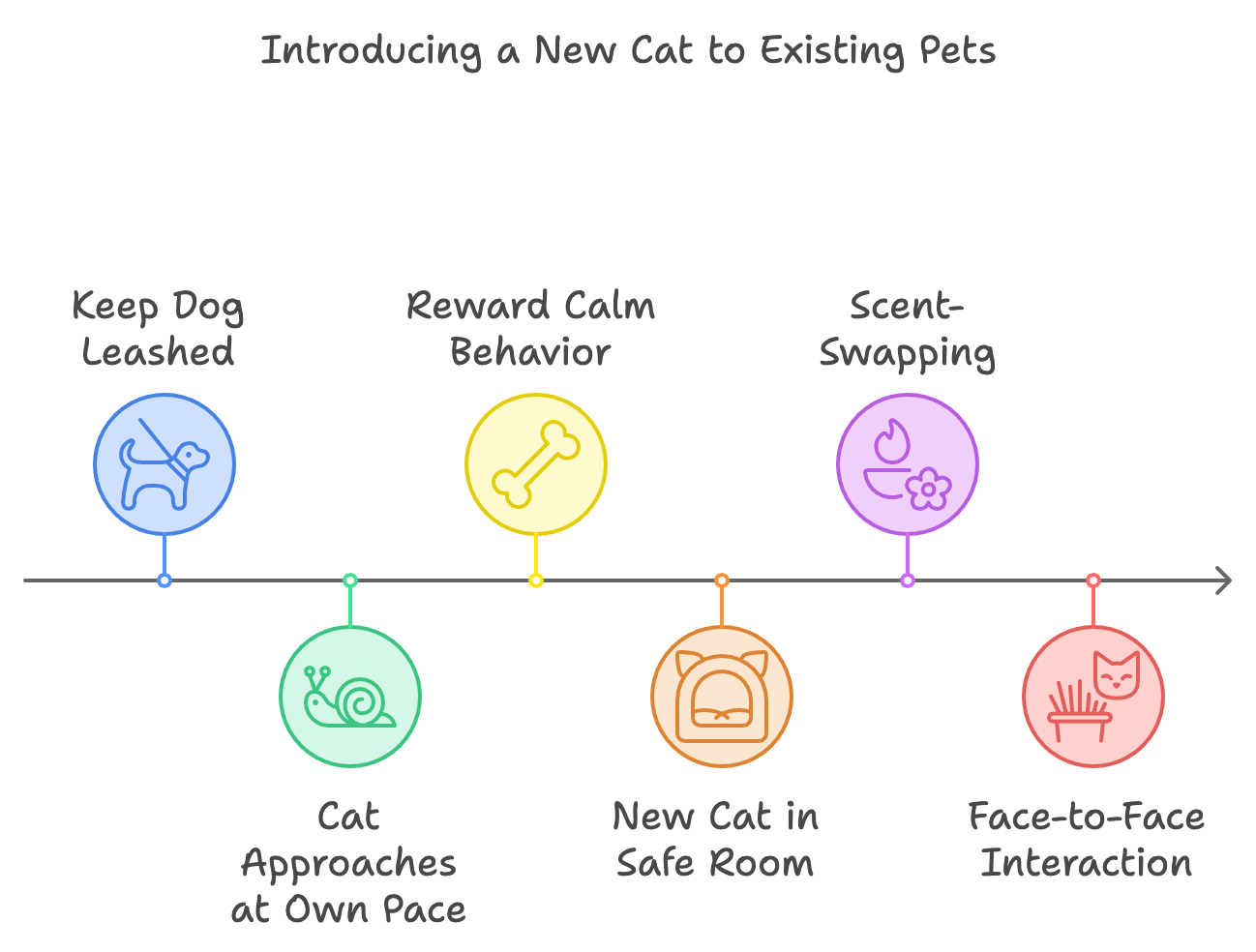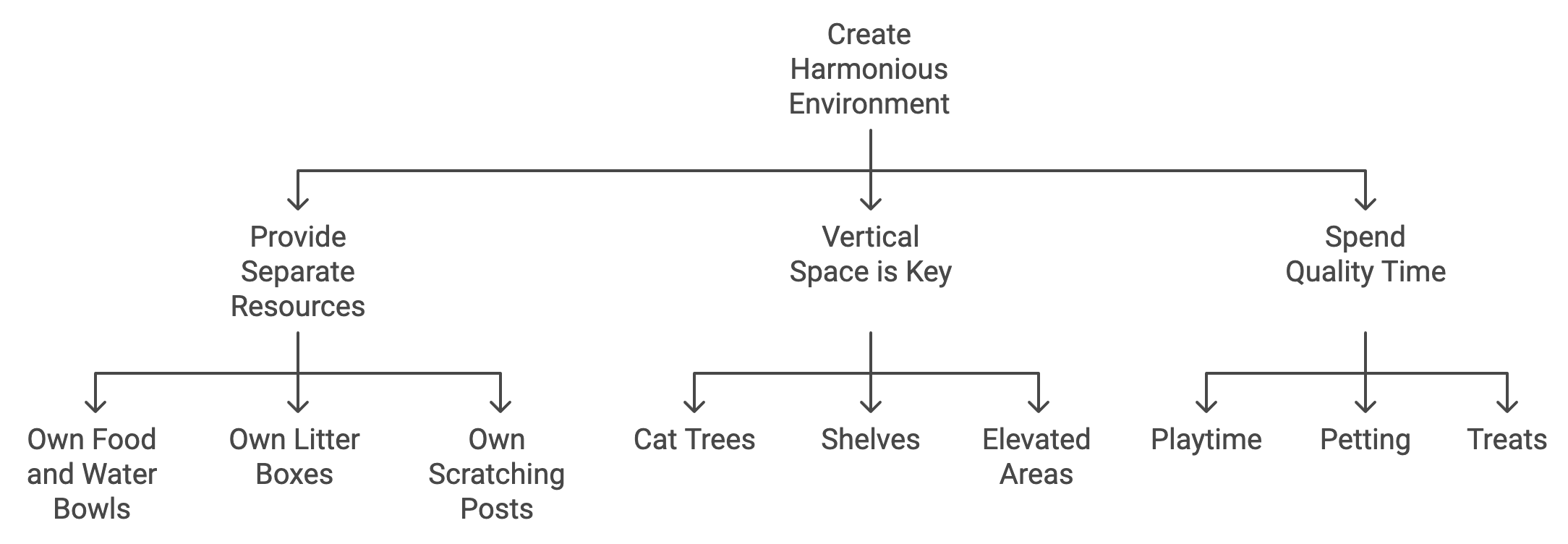
How to Introduce a New Cat to Your Home (and Existing Pets)
Table of Contents
Introducing a new cat to your home can be both exciting and a little nerve-wracking—especially if you already have pets that you want to get along well with the newcomer. Whether it’s your first time adding a furry friend to your family or you’re a seasoned cat parent, this guide will help you create a smooth transition for everyone involved. Our goal is to make sure you, your current pets, and your new kitty are happy and comfortable during this big change.
Setting the Stage: Preparing Your Home

Before bringing your new cat home, preparation is key. Cats are territorial creatures, and introducing a new cat into an existing pet environment requires a thoughtful approach. Start by creating a separate space for your new cat. This room will be your new kitty’s sanctuary—a safe place where they can get used to the sights, sounds, and smells of their new surroundings without feeling overwhelmed.
1. Designate a Safe Room
Choose a quiet room that your existing pets don’t use often. Make sure it has everything your new cat needs: a litter box, food and water bowls, scratching posts, toys, and a comfortable bed. The idea is to give your new cat a chance to acclimate to their new environment gradually.
2. Scent Swapping
Cats rely heavily on their sense of smell to recognize and understand their world. To help both your new and existing cats get familiar with each other, try scent swapping. Take a clean cloth and gently rub it over your new cat, then place it in an area where your existing pets spend time. Do the same for your existing pets and leave it in your new cat’s room. This way, they can become familiar with each other’s scent before they meet face-to-face.
Key Takeaway: Preparing a safe space and doing some scent swapping can make the introduction process much smoother by reducing the initial shock of a new presence in the home.
First Impressions: The Introduction Process

When it comes to introducing a new cat to your existing pets, patience is crucial. Rushing this process can lead to stress and conflicts that are difficult to undo. Here’s a step-by-step guide to help you make those initial introductions go smoothly.
1. Let Them Hear Each Other First
Before they see each other, let your cats get accustomed to each other’s presence through sound. You can let your existing cat sniff around the door of the new cat’s room. They may hiss or growl, which is normal at first. Give them time to process these new sounds without forcing a meeting.
2. Gradual Visual Introduction
Once both cats seem relatively comfortable with the scents and sounds, it’s time for a visual introduction. You can use a baby gate or leave the door slightly ajar while keeping an eye on them. If they seem calm and curious, reward them with treats. If there is hissing or signs of aggression, take a step back and give it more time before trying again.
3. Short, Supervised Visits
When both cats are ready, allow short, supervised visits. Keep these meetings brief—just a few minutes at first—and gradually increase the time as they become more comfortable. Always supervise these interactions to ensure the safety of both cats.
Key Takeaway: Take your time with introductions. Let your cats get used to each other’s scent, then sound, and finally, their presence. Rushing this process can cause stress and potential conflicts.
Managing Existing Pets

If you have other pets like dogs or more territorial cats, the introduction process may need extra steps. Dogs, for example, need to be kept calm and under control when meeting a new cat for the first time.
1. Introducing Your Cat to a Dog
When introducing a new cat to a dog, keep the dog on a leash and ensure they are calm. Let the cat approach at their own pace. Your dog should be trained to stay calm around the new kitty, and rewarding calm behavior with treats is a great way to reinforce this.
2. Dealing with Territorial Cats
If your existing cat is particularly territorial, extra patience is required. You may need to keep the new cat in their safe room for a longer period, continuing scent-swapping for a week or more before attempting face-to-face interactions.
Key Takeaway: Each pet is unique. Some will warm up quickly, while others will need more time. Stay patient and let each animal move at their own pace.
Signs of Progress and Potential Issues
Watching for signs that things are going well—or not—is essential. Here are some common signs of progress, as well as red flags to watch out for.
Signs Things Are Going Well
- Curiosity Without Aggression: If your pets are calmly sniffing each other or showing curiosity without hissing or swatting, it’s a good sign.
- Relaxed Body Language: Cats with relaxed ears and a neutral tail position are showing that they’re comfortable.
- Playful Behavior: If they start playing (even if it’s cautious at first), that’s a sign they’re warming up to each other.
Red Flags to Watch For
- Constant Hissing or Growling: Occasional hissing is normal, but if it’s constant, your pets may need more time apart.
- Swatting or Lunging: Aggressive behavior can escalate quickly. If you see any sign of swatting or lunging, separate the pets immediately and give them more time to adjust.
- Hiding or Avoidance: If one of your cats is constantly hiding, they may be feeling stressed or threatened. Give them more space and try again later.
Key Takeaway: Patience and observation are key. Look for relaxed, curious behavior, and take a step back if you see signs of stress or aggression.
Creating a Harmonious Environment

To help your cats live peacefully together, it’s important to create an environment where they each have their own space. Cats are territorial, and sharing can be challenging, especially in the beginning.
1. Provide Separate Resources
Make sure each cat has their own food and water bowls, litter boxes, and scratching posts. The general rule is one litter box per cat, plus one extra. This helps reduce competition and stress, making each cat feel secure in their environment.
2. Vertical Space is Key
Cats love vertical space. Cat trees, shelves, or other elevated areas can give them a sense of security and allow them to observe each other from a distance. Vertical space can also help reduce territorial disputes by allowing cats to avoid each other if they need space.
3. Spend Quality Time with Each Pet
Make sure you’re spending quality one-on-one time with each of your pets. This helps reduce jealousy and reassures them that they’re still loved. Playtime, petting, and treats can all help strengthen your bond.
Key Takeaway: Providing each cat with their own resources and opportunities for space can significantly reduce stress and foster a peaceful environment.
Common Questions About Introducing a New Cat
How Long Does It Take for Cats to Get Along?
Every cat is different. Some cats may get along within a few days, while others may take weeks or even months. The key is to go at their pace and not rush the process.
What If My Cats Never Get Along?
In rare cases, some cats may never be best friends. However, they can still coexist peacefully. Give them separate areas of the home and avoid forcing interactions.
How Can I Tell If They’re Ready for Full Access?
When your cats are comfortable being around each other without signs of aggression or stress, they’re ready for full access to the house. Continue to supervise their interactions until you’re confident they’re fully comfortable.
Cherish the Small Wins
Introducing a new cat to your home and existing pets can take time, but it’s well worth the effort. Remember that each pet is unique, and while some may adjust quickly, others may need a little more time. Celebrate the small wins—a moment of calm sniffing, a shared nap, or even just peacefully coexisting in the same room. These moments are all steps toward a happy, harmonious home.
Have you recently introduced a new cat to your home? We’d love to hear about your experience! Share your story in our cat community and connect with other cat parents who have been through the same journey.
Disclosure: This post contains affiliate links. If you purchase through these links, we may earn a commission at no extra cost to you.










